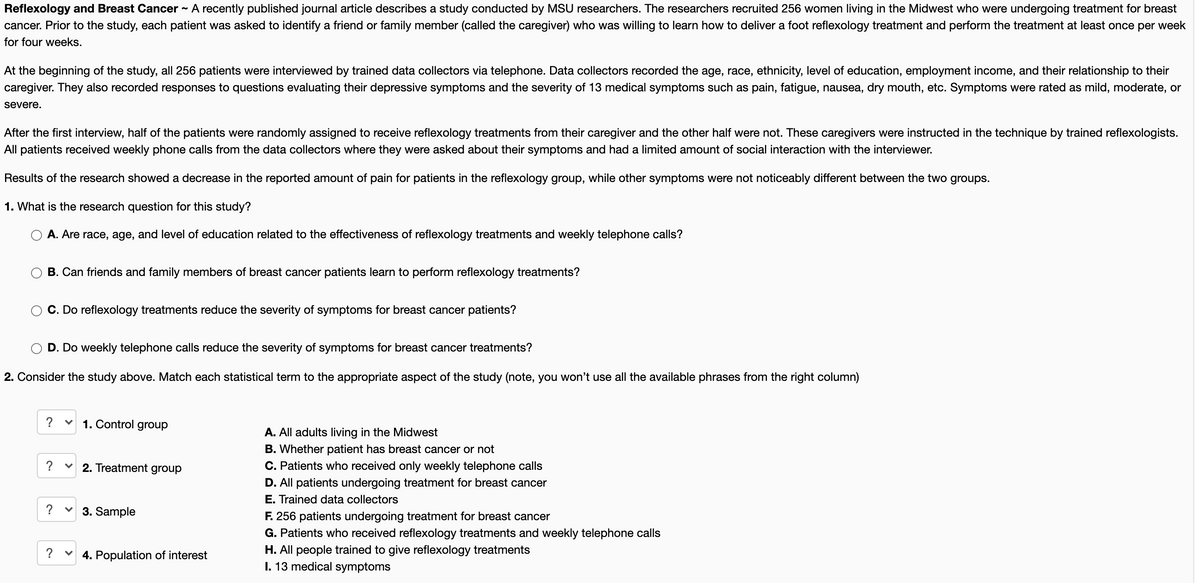1. What is the research question for this study? O A. Are race, age, and level of education related to the effectiveness of reflexology treatments and weekly telephone calls? B. Can friends and family members of breast cancer patients learn to perform reflexology treatments? C. Do reflexology treatments reduce the severity of symptoms for breast cancer patients? D. Do weekly telephone calls reduce the severity of symptoms for breast cancer treatments? 2. Consider the study above. Match each statistical term to the appropriate aspect of the study (note, you won't use all the available phrases from the right column) ? v 1. Control group A. All adults living in the Midwest B. Whether patient has breast cancer or not C. Patients who received only weekly telephone calls D. All patients undergoing treatment for breast cancer ? v 2. Treatment group E. Trained data collectors ? v 3. Sample F. 256 patients undergoing treatment for breast cancer G. Patients who received reflexology treatments and weekly telephone calls H. All people trained to give reflexology treatments I. 13 medical symptoms ? v 4. Population of interest
1. What is the research question for this study? O A. Are race, age, and level of education related to the effectiveness of reflexology treatments and weekly telephone calls? B. Can friends and family members of breast cancer patients learn to perform reflexology treatments? C. Do reflexology treatments reduce the severity of symptoms for breast cancer patients? D. Do weekly telephone calls reduce the severity of symptoms for breast cancer treatments? 2. Consider the study above. Match each statistical term to the appropriate aspect of the study (note, you won't use all the available phrases from the right column) ? v 1. Control group A. All adults living in the Midwest B. Whether patient has breast cancer or not C. Patients who received only weekly telephone calls D. All patients undergoing treatment for breast cancer ? v 2. Treatment group E. Trained data collectors ? v 3. Sample F. 256 patients undergoing treatment for breast cancer G. Patients who received reflexology treatments and weekly telephone calls H. All people trained to give reflexology treatments I. 13 medical symptoms ? v 4. Population of interest
Glencoe Algebra 1, Student Edition, 9780079039897, 0079039898, 2018
18th Edition
ISBN:9780079039897
Author:Carter
Publisher:Carter
Chapter10: Statistics
Section10.6: Summarizing Categorical Data
Problem 28PPS
Related questions
Question

Transcribed Image Text:Reflexology and Breast Cancer
cancer. Prior to the study, each patient was asked to identify a friend or family member (called the caregiver) who was willing to learn how to deliver a foot reflexology treatment and perform the treatment at least once per week
A recently published journal article describes a study conducted by MSU researchers. The researchers recruited 256 women living in the Midwest who were undergoing treatment for breast
for four weeks.
At the beginning of the study, all 256 patients were interviewed by trained data collectors via telephone. Data collectors recorded the age, race, ethnicity, level of education, employment income, and their relationship to their
caregiver. They also recorded responses to questions evaluating their depressive symptoms and the severity of 13 medical symptoms such as pain, fatigue, nausea, dry mouth, etc. Symptoms were rated as mild, moderate, or
severe.
After the first interview, half of the patients were randomly assigned to receive reflexology treatments from their caregiver and the other half were not. These caregivers were instructed in the technique by trained reflexologists.
All patients received weekly phone calls from the data collectors where they were asked about their symptoms and had a limited amount of social interaction with the interviewer.
Results of the research showed a decrease in the reported amount of pain for patients in the reflexology group, while other symptoms were not noticeably different between the two groups.
1. What is the research question for this study?
A. Are race, age, and level of education related to the effectiveness of reflexology treatments and weekly telephone calls?
B. Can friends and family members of breast cancer patients learn to perform reflexology treatments?
C. Do reflexology treatments reduce the severity of symptoms for breast cancer patients?
D. Do weekly telephone calls reduce the severity of symptoms for breast cancer treatments?
2. Consider the study above. Match each statistical term to the appropriate aspect of the study (note, you won't use all the available phrases from the right column)
?
1. Control group
A. All adults living in the Midwest
B. Whether patient has breast cancer or not
?
2. Treatment group
C. Patients who received only weekly telephone calls
D. All patients undergoing treatment for breast cancer
E. Trained data collectors
F. 256 patients undergoing treatment for breast cancer
G. Patients who received reflexology treatments and weekly telephone calls
H. All people trained to give reflexology treatments
I. 13 medical symptoms
?
3. Sample
?
v 4. Population of interest
Expert Solution
This question has been solved!
Explore an expertly crafted, step-by-step solution for a thorough understanding of key concepts.
This is a popular solution!
Trending now
This is a popular solution!
Step by step
Solved in 3 steps

Knowledge Booster
Learn more about
Need a deep-dive on the concept behind this application? Look no further. Learn more about this topic, statistics and related others by exploring similar questions and additional content below.Recommended textbooks for you

Glencoe Algebra 1, Student Edition, 9780079039897…
Algebra
ISBN:
9780079039897
Author:
Carter
Publisher:
McGraw Hill

Holt Mcdougal Larson Pre-algebra: Student Edition…
Algebra
ISBN:
9780547587776
Author:
HOLT MCDOUGAL
Publisher:
HOLT MCDOUGAL

Glencoe Algebra 1, Student Edition, 9780079039897…
Algebra
ISBN:
9780079039897
Author:
Carter
Publisher:
McGraw Hill

Holt Mcdougal Larson Pre-algebra: Student Edition…
Algebra
ISBN:
9780547587776
Author:
HOLT MCDOUGAL
Publisher:
HOLT MCDOUGAL